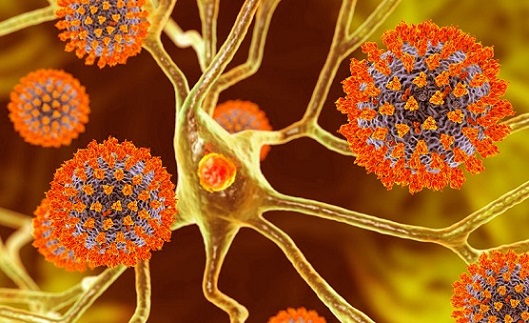SARS-CoV-2 infects iPSC-derived neurons and causes brain degeneration with cathepsin B playing a crucial role in viral entry
Nikhil Prasad Fact checked by:Thailand Medical News Team Nov 25, 2024 5 months, 3 weeks, 6 days, 22 hours, 52 minutes ago
Medical News: Researchers from the University of Helsinki, Finland, and The University of Queensland, Australia, have unveiled groundbreaking findings on how SARS-CoV-2, the virus responsible for COVID-19, impacts the human brain. This study revealed the virus's ability to infect neurons derived from human-induced pluripotent stem cells (hiPSCs) and induce neurodegenerative effects, spotlighting cathepsin B as a pivotal factor in viral entry.
 SARS-CoV-2 infects iPSC-derived neurons and causes brain degeneration with cathepsin B
SARS-CoV-2 infects iPSC-derived neurons and causes brain degeneration with cathepsin B
playing a crucial role in viral entry
The international research team included scientists such as Pinja Kettunen, Janika Ruuska, Tania Quirin, and others, hailing from prestigious institutions like the Helsinki Institute of Life Science, the Australian Institute for Bioengineering and Nanotechnology, and the Queensland Brain Institute. This
Medical News report delves into their findings and implications for our understanding of COVID-19's effects on the brain.
SARS-CoV-2 and Brain Neurons: A Lethal Interaction
SARS-CoV-2 is widely known as a respiratory virus, but its ability to infect brain cells raises concerns about its broader impacts. Researchers previously demonstrated that the virus could infiltrate hiPSC-derived neurons via endosomal pathways. Notably, this process relied on cathepsins, including cathepsin B, and was independent of transmembrane serine protease 2 (TMPRSS2), typically involved in viral entry.
This study advanced prior knowledge by highlighting how both the Wuhan and Omicron XBB.1.5 variants infect neurons. The researchers used neuron-astrocyte co-cultures and 3D cortical organoids to replicate the brain's environment. They found that cathepsin inhibitors, particularly CA-074-ME, could effectively block neuronal infections, significantly reducing the virus's ability to spread.
Cathepsin B: A Crucial Doorway for the Virus
Cathepsins, a group of proteases involved in cellular processes, emerged as key players in viral entry. The study demonstrated that the inhibitor CA-074-ME, targeting cathepsin B, reduced infection by up to 90% in neuron models. By contrast, cathepsin L inhibitors like SB412515 showed limited efficacy against the Wuhan strain but performed better against the Omicron variant.
Interestingly, the researchers observed variations in cathepsin expression levels between cell types. Neurons expressed higher levels of cathepsin B than cathepsin L, possibly explaining the former's critical role in facilitating SARS-CoV-2 entry. This finding highlights the potential for targeting cathepsin B as a therapeutic strategy to mitigate viral impacts on the brain.
Neurodegeneration: A Worrying Outcome
The study identified significant neurodegenerative changes in infected neurons. These included:
-Tau Hyperphosphorylation: A hallmark of Alzheimer’s dise
ase, hyperphosphorylated tau proteins were mislocalized to the neurons' soma.
-Cellular Stress Indicators: An increase in the hypoxia-inducible factor 1-alpha (HIF-1α) was observed in infected neurons, marking heightened stress responses.
-Inflammatory Responses: Elevated levels of cytokines like MCP-1 and MIF were detected, suggesting an activated immune response.
These changes align with Alzheimer's-like pathologies, pointing to long-term neurological implications for individuals recovering from COVID-19.
Infectious Virions: A Double-Edged Sword
One of the study's striking findings was the productive nature of SARS-CoV-2 infection in neurons. While neurons could release infectious virions, the infectivity peaked within 24 hours and declined over time. This decline was attributed to potential antiviral responses initiated by the neurons or surrounding astrocytes.
However, the researchers noted that infected neurons eventually succumbed to the virus, as evidenced by a gradual reduction in their numbers over five days. These observations underline the virus's ability to compromise neuronal health and functionality.
The Role of 3D Brain Models
The study also utilized cortical organoids containing choroid plexus-like cells to confirm the findings. These 3D models, which better mimic brain architecture, showed slower viral spread than 2D cultures. Despite this, the organoids supported robust infection, reinforcing the role of cathepsin B in viral entry.
Notably, the use of CA-074-ME significantly reduced viral infection in these models, suggesting its potential application in preventing SARS-CoV-2's neurological impacts.
Implications for Treatment
The findings highlight the promise of cathepsin inhibitors like CA-074-ME in combating SARS-CoV-2's effects on the brain. While these inhibitors effectively block viral entry in neurons, their potential neuroprotective properties add an additional layer of therapeutic value.
Future research could focus on developing drugs targeting cathepsin B and testing their efficacy in vivo. The study also emphasizes the need for "pan-variant" antivirals to address the evolving nature of SARS-CoV-2.
Conclusion
This study provides compelling evidence of SARS-CoV-2's neurodegenerative potential. By demonstrating the virus's reliance on cathepsin B for neuronal entry and its ability to induce Alzheimer’s-like changes, the research underscores the importance of addressing the neurological impacts of COVID-19. The findings also pave the way for targeted therapies that could mitigate these effects, offering hope for those at risk of long-term complications.
The study findings were published on a preprint server and are currently being peer reviewed.
https://www.biorxiv.org/content/10.1101/2024.11.21.624622v1
For the latest COVID-19 News, keep on logging to Thailand
Medical News.
Read Also:
https://www.thailandmedical.news/news/u-s-study-finds-that-sars-cov-2-invades-the-peripheral-sensory-neurons-first-before-spreading-through-the-bloodstream
https://www.thailandmedical.news/news/sars-cov-2-proteins-can-form-neurotoxic-amyloid-assemblies-that-are-taken-up-by-host-neurons
https://www.thailandmedical.news/news/covid-19-news-weill-cornell-study-finds-that-sars-cov-2-infects-and-triggers-senescence-of-dopamine-neurons-metformin-helps
https://www.thailandmedical.news/news/breaking-covid-19-news-sars-cov-2-also-targets-human-motor-neurons-expect-more-neuromuscular-issues-in-post-covid-phase
https://www.thailandmedical.news/news/sars-cov-2-e-protein-triggers-neuron-cell-death-via-calcium-release
